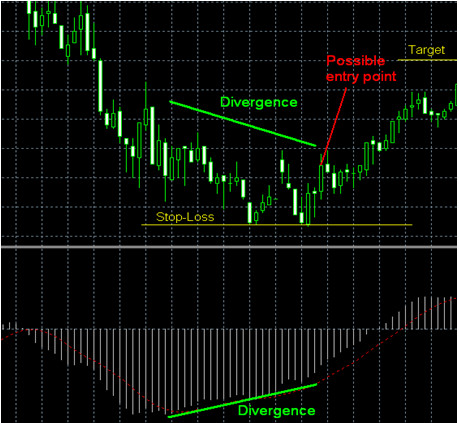MACD Divergence Strategy – Zooming in to 15 Minutes
Full Review of the MACD Divergence Strategy for Binary Options
MACD, or moving average convergence divergence, is one of my favorite tools for binary options. It is useful in multiple timeframes, can be used with any asset and gives a variety of reliable signals. This strategy utilizes one of the standard divergence signals given by MACD for trading 15 minute charts.
http://www.earnforex.com/forex-strategy/macd-divergence-strategy
What Is The MACD Divergence Strategy
This is a strategy I found while surfing the web and one I can fully stand behind. This is a great application of a standard MACD signal and easy to apply to binary options. First, for those of you new to trading, MACD is a technical indicator used to measure market momentum. It measures the convergence and divergence of two moving averages, hence the name; Moving Average Convergence Divergence. It is an oscillator that can be displayed in two ways, standard and histogram. The standard view looks a lot like other oscillators including stochastic and RSI. It has two lines that move above and below each other and in between two extremes. The histogram is a pictographic view of the convergence and divergence of the two lines. Both views offer deep insight into market momentum but this strategy focuses on the histogram view.

How Does The MACD Divergence Strategy Work
This strategy focuses on MACD divergences and seeks to capture the quick moves that come with corrections and reversals. The authors claim it is a “quick and reliable system and is based on standard MACD indicator”. I tend to agree with them but it does need a little tweaking. The system is based on a single indicator and a single signal, a practice I am not in tune with. However, combining the MACD divergence signal with another indicator like a Fibonacci, resistance line or EMA makes it much more reliable. So, what exactly is a MACD divergence? This is a semi-rare, contrarian signal that marks an impending market correction or relief rally. Looking at the shot of MACD above you can see that it is making a series of higher peaks followed by one lower peak. If those higher peaks were coincident with higher peaks in the market we would call them convergent. If the last and lower MACD peak happened while the market made a higher high we would call that divergent. When a divergence happens it signals that momentum is weakening and that the market is ripe for pullback, correction or relief rally. This MACD shot was taken from the USD/JPY daily chart, the divergence came just before a major correction.

Why the MACD Divergence Strategy Doesn’t Suck
The great thing about MACD divergence is that it can happen in multiple time frames, be bullish or bearish, combines well with other techniques and it works with any asset with a price chart. These reasons add up to an indicator and system that definitely does not suck. Of course, I am biased because I love the MACD indicator and utilize divergence theory in my daily trading. This system uses the standard setting of 12-26-9, the same one I use. The signal is easy to spot with the suggested chart of 15 minute candles it will work well with expiry of 1-4 hours. For longer term traders simply move up to charts of one hour candles for end of day or end of week expiration and daily charts for one week to one month expiration.
Why the MACD Divergence Strategy does Sucks
As written this strategy sucks. The signals are few and far between, unreliable and have vague entry points. The main reason for this is because it only uses one indicator and one signal. I find it odd that the main selling points of the strategy are also its main drawbacks. I mean seriously, the strategy is advertised as “easy to spot”, “only uses one indicator” and has a “high profit potential”. And they even admit that the entry and exits are “fuzzy”. Fuzzy may be good enough for you but I don’t like to trade on fuzzy signals, I like strong signals with easily identified entry targets.
The Last Word On The MACD Divergence Strategy
This is a good strategy, don’t use it by itself though. Divergences are tricky little buggers that will tempt you into a high risk trade. The best thing will be to utilize the multiple time-frame technique and look for what I call a convergence of divergence. If you can find a divergence on a weekly chart, a daily chart and an hourly chart at the same time then odds are high that a contrarian position with a one hour to one expiration will pay off. Another way to maximize this strategy is to add other indicators to it. I like to use stochastic, trend line, Fibonacci and 30/150 bar EMA’s with my MACD. When these things combine to tell me a divergence could pay off it always pays to listen.